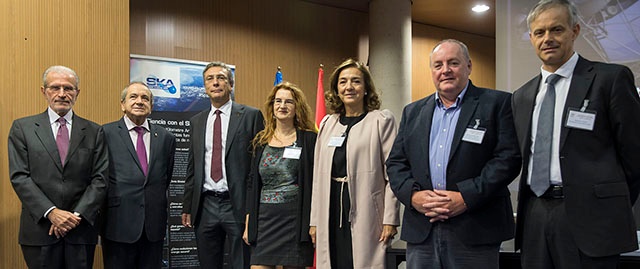Institute for Corpuscular Physics (IFIC) gather Scientifics from various disciplines to discuss the capabilities of the SKA project, the largest radiotelescope in the world that will open new possibilities to Universe study. The event will take place at the Parc Científic on 6 and 7 November. This conference has been opened by the secretary of State, Carmen Vela, the president of CSIC, Emilio Lora-Tamayo, the Principal Esteban Morcillo, the General Director of SKA, Philip J. Diamond, the coordinator of RIA, Vicent Martínez, and the director of IFIC, Juan José Hernández Rey.
The meeting, entitled “Physical Opportunities with a new vision of the Universe: the SKA radiotelescope”, is aimed at strengthening the relationship between SKA and different scientific disciplines, such as Astrophysics, Astrobiology and Particle and Astroparticle Physics. IFIC and the Astronomical Observatory of the Universitat de València are involved in the project.
The Square Kilometre Array (SKA) is a great international project to build the largest radiotelescope in the world. It is made up of thousands of antennas distributed over distances of up to 3,000 kilometres whose total collecting area will be equivalent to one square kilometre. SKA is not only one telescope, but a collection of telescopes, called array, distributed over large distances and connected by interferometry. Its construction is planned in two phases: Phase 1 (SKA1), in South Africa and Australia, and Phase 2 (SKA2), in which it will be extended to other countries in the African continent and the Australian component will be expanded.
Considered a Reference Project in the European Strategy Forum on Research Infrastructures (ESFRI), the SKA will carry out transformational science to improve our understanding of the Universe and the fundamental physical laws, observing the sky with a unprecedented detail and drawing a star chart hundreds of times faster than any current installation. In addition, it will provide unique information about the so-called “dark ages” of the Universe, a period characterized by the absence of individual sources of light prior to the reionization stage, and one of the most unknown stages of the Universe.
Hence the interest that the project has for the scientific community of particle physics, and therefore, for the IFIC, in whose scientific collaboration participate this mixed center of the Universitat de València and The Spanish National Research Council (CSIC) SKA will supply new information about the nature of the mysterious dark matter and energy, which make up more than 95% of the universe but which remain unknown to science. In this sense, SKA will complement other quests for dark matter that are carried out directly in the Large Hadron Collider (LHC) of CERN, or indirectly using neutrino telescope such as ANTARES/KM3Net, both with participation of the IFITC.
SKA will also make cosmological measurements that will be used to establish the mass of neutrinos, a field where the IFIC works in experiments such as T2K, DUNE or NEXT. Furthermore, it will study pulsars and black holes, providing new information to the theories that try to unify gravity with the rest of the forces of the universe.
The principal objective of this meeting is to maximise the interrelation between SKA and the Spanish research communities beyond radio astronomy. In particular, it will participate experts in particles, astroparticles, planetary sciences, astrobiology and cosmology -states the organiser, Olga Mena, researcher at the Institute for Corpuscular Physics associated with the working group dedicated to Cosmology at SKA.
For her part, Lourdes Verdes-Montenegro, researcher at the Institute of Astrophysics of Andalucia (IAA-CSIC) and coordinator of scientific, technological and industrial participation of Spain in SKA, has indicated that Spain has been positioned to achieve the maximum scientific, industrial and technological return of a transdisciplinary project like the SKA. This meeting is fundamental to identify the synergies in Spanish scientific community and strengthened it.
The IAA and the Astronomic Observatory of the Universitat de València are, besides, members of SKA Communications and Outreach Network (SKACON), network that is in charge of spreading and dissemination of the SKA Project, whose Spanish coordination is carried out through Astronomy Infrastructure Network (RIA), orchestrated by the professor of Astronomy of the Universitat de València Vicent Martínez, and sponsor of this conference.
Although the participation of Spanish science and industry in SKA is active, we are not yet a full member country in this consortium-comments José Carlos Guirado, director of the Astronomical Observatory of the Universitat de València and member of the RIA. Nevertheless, the prospects are good and we hope that this meeting will help to promote the recognition of SKA as a priority in scientific policies - he concludes.
In this regard, the Secretary of State, Carmen Vela, has committed to support SKA and help Spain to be recognised as a full member of the project. Spain and its industry is ready scientifically and technologically to be part of this initiative - he said
Currently, 25 Spanish physicists participate in SKA scientific work groups, and 20 institutions and companies contribute to international consortium for their design. In 2016, a report from the Secretary of State assessed positively the full participation of Spain in SKA. This has been followed by negotiations with the SKA Board of Directors to find the best way for Spain to join SKA as Full Member.
The conference is taking place at the Assembly Hall of the building of Institutes of the Parc Científic


